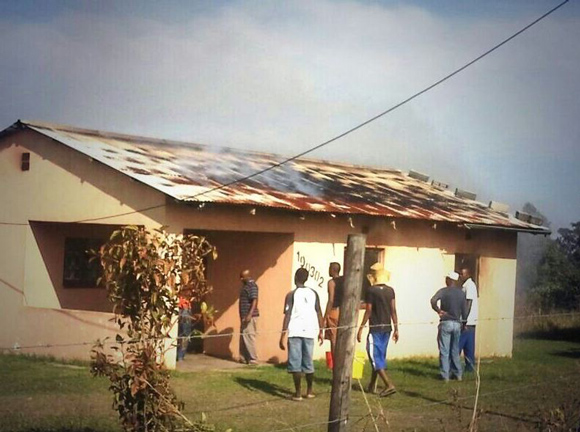In the serene and expansive settings of rural areas, fire safety presents unique challenges and considerations. Unlike urban environments, rural homes are often situated in remote locations, surrounded by vast landscapes that can either act as a barrier or a conduit for wildfires.
Additionally, the Unique Challenges in Rural Fire Safety stem from a blend of environmental and lifestyle factors. These include the proximity to forests and grasslands, which may increase the risk of wildfires, and the reliance on wood-burning stoves or open flames for heating and cooking, which can pose significant fire hazards within the home. This introduction aims to set the stage for exploring tailored strategies and solutions to address these distinctive fire safety challenges faced by rural homeowners.

Assessing Fire Risks in Rural Areas
Rural homes in South Africa face specific fire risks, often distinct from urban settings. Common Fire Hazards in Rural Homes include factors such as the use of open flames for cooking or heating, which can escalate quickly if not monitored properly. Additionally, many rural homes may store flammable materials like fuel for farming equipment, increasing the risk of accidental fires.
The Impact of Remote Locations on Fire Safety is significant. These areas might be far from the nearest fire station, leading to longer response times in emergencies. The isolation also means that community self-reliance becomes crucial in early fire detection and initial firefighting efforts.
Fire Prevention Strategies for Rural Homes
In the context of rural South Africa, Safe Heating Practices are vital. This includes ensuring proper installation and maintenance of heating equipment to prevent accidents. Educating homeowners about the safe use of open flames and alternative, safer heating methods can also reduce risks.
Mitigating Risks from Agricultural Activities is another key area. This involves safe storage and handling of combustible materials like hay, crop residues, and chemicals. Regular inspection of electrical equipment used in farming operations can prevent electrical fires.
Emergency Services and Rural Communities
Rural communities often face Challenges in Accessing Emergency Services. The distance from fire stations and hospitals means that immediate professional help may not always be readily available. This situation necessitates a proactive approach to fire safety and emergency preparedness.
To address these challenges, Community-Based Response Initiatives can be a game-changer. Forming local volunteer fire brigades, developing community alert systems, and conducting regular fire safety training sessions can empower rural communities to respond effectively to fires and other emergencies.

Creating an Effective Fire Response Plan
Developing a Rural Fire Emergency Plan involves outlining specific actions to be taken in the event of a fire. This plan should include evacuation routes, meeting points, and methods for alerting emergency services. It’s crucial for rural households to have a clear, practicable plan that accounts for their remote location and potential communication challenges.
Essential Components of a Rural Fire Safety Kit should be tailored to the unique needs of rural living. This kit might include items such as fire blankets, water buckets or hoses, a portable radio for emergency alerts, and basic first aid supplies. It’s also important to have a list of emergency contact numbers readily available.
Utilizing Technology for Fire Safety
Innovative Fire Detection and Alert Systems can significantly enhance fire safety in rural areas. Technologies like smoke detectors with long-range connectivity or apps that provide real-time fire alerts can be life-saving.
The Role of Technology in Enhancing Rural Fire Safety extends beyond detection. It includes using online platforms for fire safety education, GPS for pinpointing locations in emergencies, and leveraging social media for community-wide alerts and coordination.
Post-Fire Recovery and Support
Strategies for Recovery after a Rural Fire focus on both the immediate aftermath and long-term rebuilding. This includes assessing and repairing property damage, dealing with insurance claims, and addressing emotional and psychological impacts.
Accessing Support and Resources in Rural Communities is crucial for recovery. Rural residents may need to rely on a network of community support, government assistance, and non-profit organizations to navigate the recovery process. Establishing strong communication channels and being aware of available resources before a disaster strikes can expedite this process.

In conclusion, ensuring fire safety in rural homes is a critical and multi-layered effort. Key takeaways include:
- Understanding Unique Risks: Recognizing the specific fire hazards that rural homes face.
- Comprehensive Prevention Strategies: Implementing both structural and non-structural measures to mitigate fire risks.
- Leveraging Technology: Utilizing advanced fire detection systems and communication tools for early alerts.
- Community Involvement: Building a community network for fire awareness, prevention, and emergency response.
- Preparedness Planning: Developing and practicing a fire response plan tailored to the rural setting.
The importance of community involvement in enhancing fire safety cannot be overstated. When residents come together to share knowledge, resources, and support, the entire community becomes more resilient against the threat of fires. This approach goes beyond protecting individual homes, it fortifies the safety and well-being of the broader rural community.

